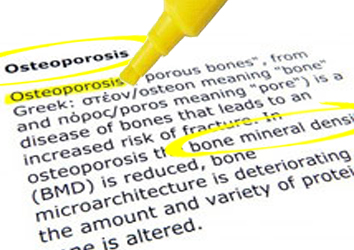Osteoporosis Definition: What is Osteoporosis, What Causes It, and How is It Diagnosed?
 There is no single best osteoporosis definition, but osteoporosis is commonly defined as a bone disease characterized by a deterioration in bone density and quality, with a consequent increase in bone fragility and susceptibility to fracture. Another common osteoporosis definition is based on a person’s dual energy x-ray absorptiometry (DEXA) score: osteoporosis is a condition in which a person’s DEXA score is -2.5 or below. We will discuss what that means in more detail below. First, let’s delve more into what osteoporosis is and why you should be concerned about it.
There is no single best osteoporosis definition, but osteoporosis is commonly defined as a bone disease characterized by a deterioration in bone density and quality, with a consequent increase in bone fragility and susceptibility to fracture. Another common osteoporosis definition is based on a person’s dual energy x-ray absorptiometry (DEXA) score: osteoporosis is a condition in which a person’s DEXA score is -2.5 or below. We will discuss what that means in more detail below. First, let’s delve more into what osteoporosis is and why you should be concerned about it.
Osteoporosis literally means porous bone. Like a honeycomb whose holes and spaces have become bigger, bones that have lost density or mass, and whose tissue structure has become abnormal, also develop bigger holes and spaces. They become more porous and fragile and are much more prone to break. In fact, even minor falls or, with severe osteoporosis, simple actions like sneezing or bumping into furniture can cause weakened bones to break.
What causes osteoporosis?
Bones are alive, constantly dissolving and re-forming in a process called remodeling. Until young adulthood, bones are developing and strengthening. A person usually reaches “peak bone mass,” when bones are most dense, in his or her early 20’s. After that, healthy bones continue the process of remodeling throughout life, but they don’t continue to get stronger. With osteoporosis, the remodeling process becomes unbalanced—the bone breakdown outpaces the re-forming of new bone, causing bones to become porous, brittle, and prone to fracture.
The true underlying causes of osteoporosis are those things that cause this remodeling process to become unbalanced. In addition to age, genetic predisposition, and loss of estrogen associated with menopause, causes of osteoporosis include dietary factors, lifestyle factors, the presence of other diseases, and the use of certain medications.
- Diets too high in animal protein, trans fats, and/or refined carbohydrates/added sugars are established causes of osteoporosis, as are diets that lack optimal amounts of vitamins, minerals, and phytonutrients.
- Being overweight, especially if you carry your weight around the mid-section, is also a cause, but so is being too thin.
- Lifestyle causes of osteoporosis include smoking, drinking alcohol, being sedentary, and chronic stress.
- Diseases that are highly associated with increased osteoporosis risk include rheumatoid arthritis, cardiovascular disease, type 2 diabetes, asthma, liver disease, inflammatory bowel disease, and celiac disease.
- Drugs that can cause osteoporosis include proton pump inhibitors, corticosteroids, tricyclic antidepressants, too much thyroid hormone, anticonvulsants, antipsychotics, and antiretrovirals.
Osteoporotic fractures
Broken bones (fractures) that occur because of osteoporosis are called osteoporotic fractures or fragility fractures. These fractures are extremely common. Studies suggest that approximately 1 in 2 women and up to 1 in 4 men age 50 and older will suffer an osteoporotic fracture. Often there are no symptoms until the first fracture occurs.
The most common fractures associated with osteoporosis occur at the hip, spine and wrist, but other bones can also break. Most concerning are spinal and hip fractures. Spinal fractures can result in serious consequences, including intense or chronic back pain, loss of height, and permanent stooping characterized by deformity (sometimes called Dowager’s Hump). Hip fractures require surgery and can easily result in loss of mobility and independence or death.
Diagnosis, prevention, and treatment of osteoporosis
To diagnose osteoporosis, your bone mineral density (BMD) needs to be measured. BMD is how much calcium and other types of minerals are in an area of your bone. While a number of different types of BMD tests are available, the most commonly used is DEXA (dual-energy X-ray absorptiometry). DEXA is a low radiation X-ray capable of detecting very small percentages of bone loss. A DEXA scan measures spine and hip bone density and scores your BMD in those areas as it compares to the average measurement in a population of healthy young adults who have peak bone mass (called a T-score). A normal T-score is -1 or above. Osteoporosis is diagnosed when a person’s BMD is equal to or more than 2.5 standard deviations below this reference measurement.
- Normal T-score: -1 or above
- Osteopenia: T-score lower than -1 and greater than -2.5
- Osteoporosis: T-score of -2.5 or lower
- Severe osteoporosis: T-score of -2.5 or lower, and presence of at least one fragility fracture
The good news is there are now many steps that can be taken to prevent and treat osteoporosis. Even if your DEXA score shows osteopenia or osteoporosis, you are not destined to have a fracture. Many fractures can be avoided with a combination of lifestyle changes, natural therapies, and, if necessary, appropriate medical treatment. If you are interested in a natural approach to preventing and treating osteoporosis, our comprehensive guide, Osteoporosis Relief: Natural Remedies for Osteoporosis Prevention and Treatment will give you complete, step-by-step instructions. Don’t wait!
[1] Medscape e-Medicine Clinical Reference. Osteoporosis. Downloaded Nov 21, 2013.


 Bone Spurs on the Spine
Bone Spurs on the Spine  Knee Injections for Osteoarthritis Pain Relief
Knee Injections for Osteoarthritis Pain Relief  What Is a Slipped Rib?
What Is a Slipped Rib? 